What Is The Principle Of Non Aqueous Titration
Theory is the same as acid-base titration Reaction carried out in a non-ahydrous medium Widely used in organic acids and bases The principle is based on the Brnsted-. Instead the electric potential across the substance is measured.
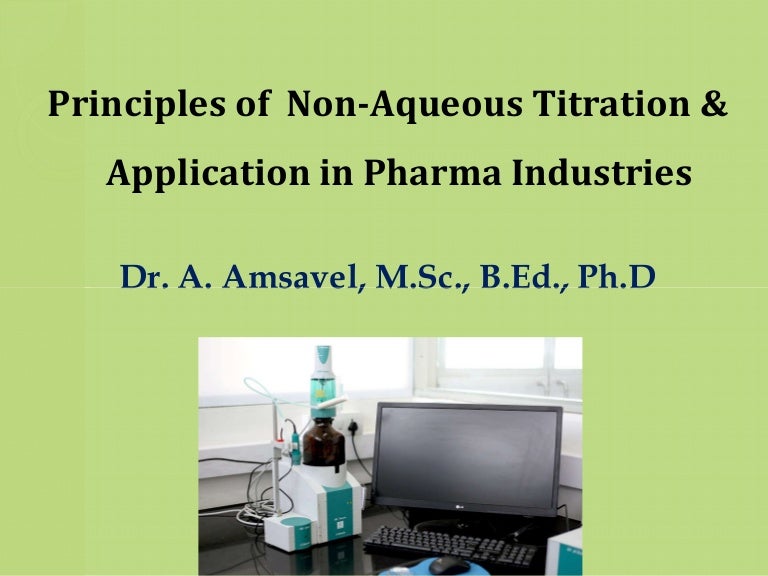
Non Aqueous Titration By Dr A Amsavel
Substance is dissolved in a solvent and titrated using acid or base as titrant.

What is the principle of non aqueous titration. Non- Aqueous Titration. The method permits a rapid determination of different types of compounds common in the. In this method there is no use of a chemical indicator.
TITRATION OF BASES The non-aqueous titration of weak bases with perchloric acid is the part of non-aqueous titrimetry that has been until now most thoroughly dealt with. To overcome this the glacial acetic acid is dissolved in non-aqueous solvent to form high concentration ions. -water insoluble -water sensitive.
THEORY The concepts of the Lowry-Bronsted theory may explain the various reactions that take place during many non-aqueous titrations. THEORY AND ROLE OF SOLVENT The role of solvent in making a substance and strongly weak acid and strongly weak base. Thus an acid is a proton donor and a base is a proton acceptor.
Therefore when an acid HA undergoes dissociation it gives rise. An example of a reaction in which water is not a suitable solvent is the reaction given by. The chemical reaction involved in titration is the main principle of titration.
Ex-Like HCL in water is strong acidic. The main principle involved in the non-aqueous titrimetric method is the samples are dissolved in the non-aqueous solvents. It is used in the characterization of acids.
A back titration is useful if the endpoint of the reverse titration is easier to identify than the endpoint of the normal titration as with precipitation reactions. But the chemical reactions also depend on the nature and strength of the reagents used in the reaction. 2 Which dont soluble in water.
Hence the non-aqueous titrimetric method is used. Titration performed in a solvent-free environment. Non-water titration NATAqueous titration NAT Non-eclectic titration.
Potentiometric titration is a laboratory method to determine the concentration of a given analyte. 2017 Ephedrine Hydrochloride contains not less than 990 per cent and not more than 1010 per cent of. The types of compounds in a non-aqueous medium that may be titrated as acids usually by lithium methoxide or tetrabutyl ammonium hydroxide include acid halides acid anhydrides carboxylic acids amino acids enols such as barbiturates and xanthines imides phenols pyrroles and sulfonamides.
Non Aqueous titration is a process of titration where all the procedure is free from water. R-NH 2 H R-NH 3. These are extremely weak and cannot be analysed using normal titrimetric methods.
The organic acids and bases are insoluble in water. Glacial acetic acid reacts with water which forms oxonium ion with low concentration. Non-aqueous titrations have the following advantages Organic acids and bases that are insoluble in water are soluble in non- aqueous solvent.
-The substances which are either too weakly acidic or too weakly basic to give. Theory is same as Acid-Base titration Reaction carry out in non-aqueous medium Extensively used for organic acids and bases Principle is based on Brnsted-Lowry Theory 6. Moisture and carbon dioxide are to be avoided in non aqueous methods 3.
Most phenomena like promoting and leveling as well as differentiating effects of common nonaqueous titrations can be explained by the Brnsteds concept combined with the hydrogen bond theory but. The substance is dissolved in a solvent and titrationd using acid or ace as a titrant. Unit II Non Aqueous Titration - Acidimetry and Alkalimetry 2.
Back titrations are also useful if the reaction between the analyte and the titrant is very slow or when the analyte is in a non-soluble solid. The procedure of non-aqueous titration is very useful because it satisfies two different requirements namely suitable titration of very weak acids or bases along with providing a solvent with an ability to dissolve organic compounds. The types of compounds in a non-aqueous.
The moisture content in nonaqueous titrations should not be more than 005. Hence non aqueous titration is a titration of substance which dissolve in non aqueous solvent and it is suitable for weak acid and weak base. The main principle involved in the non-aqueous titrimetric method is the samples are dissolved in the non-aqueous solvents.
Here both acid and base are strong. -very very weakly acidic or basic solution. INTRODUCTION Non- aqueous titrations are the titrations in which weakly acidic or basic substances are carried out using nonaqueous solvents to get sharp end point.
Estimation of Ephedrine Hydrochloride by NAT -Ephedrine Hydrochloride. So acid-base titrations or the neutralization reactions are also further divided as Strong acid vs Strong Base. Principle of Non aqueous Titration.
By this titration we can easily determine the substances which are. C 10H 15NOHCl Mol.
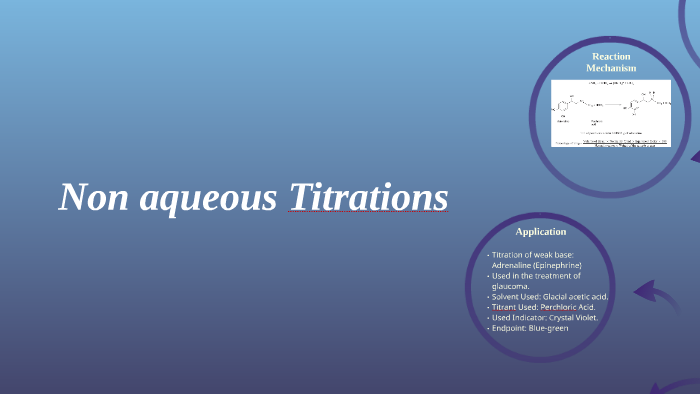
Non Aqueous Titrations By Mariam Mohamed

Pharmaceutical Analysis Pdf Free Download
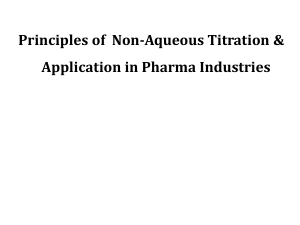
Basics Of Non Aqueous Titration

Part 1 Non Aqueous Titrations Basic Concepts Youtube
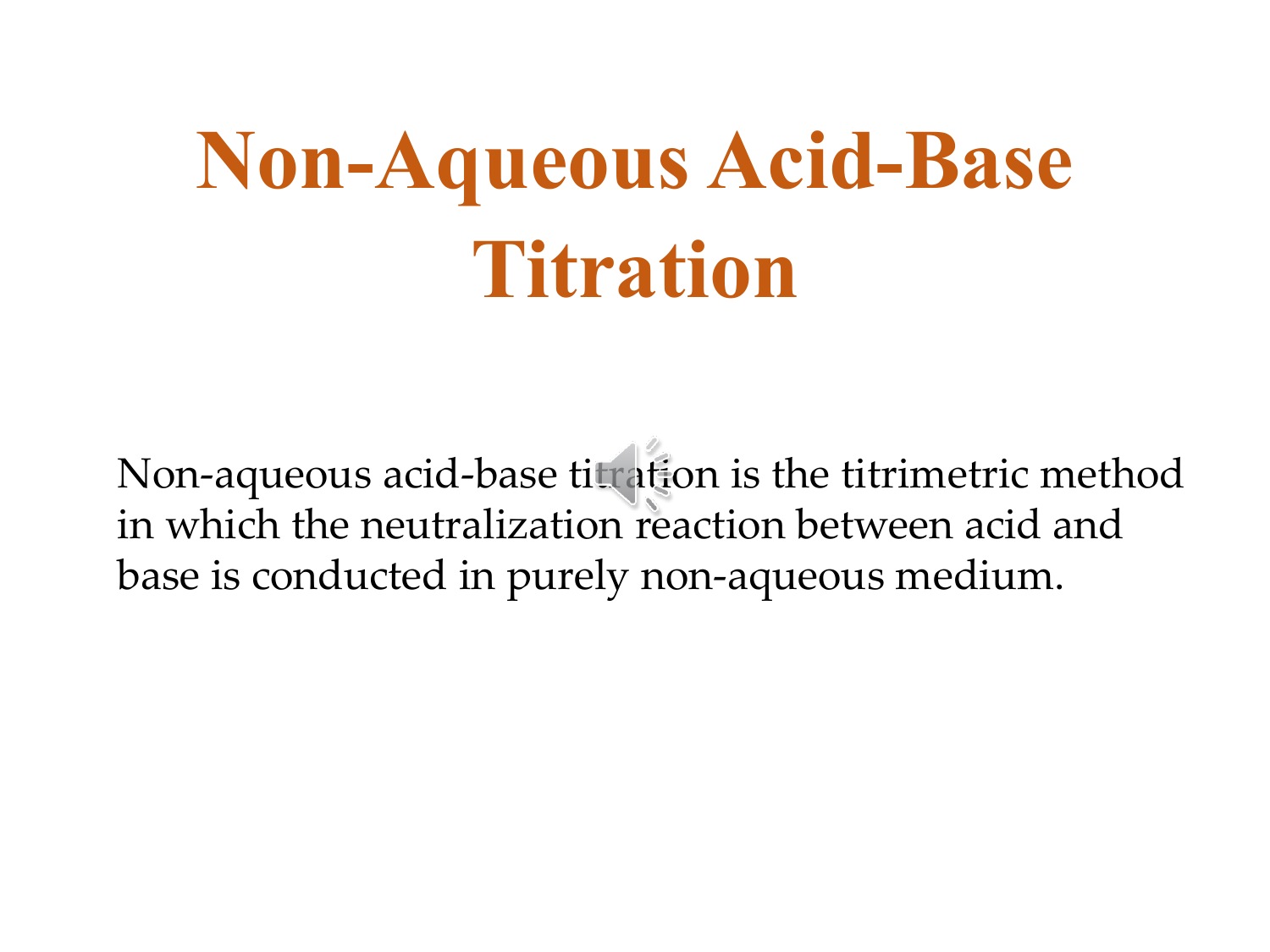
Week 7 Non Aqeous Acid Base Titration
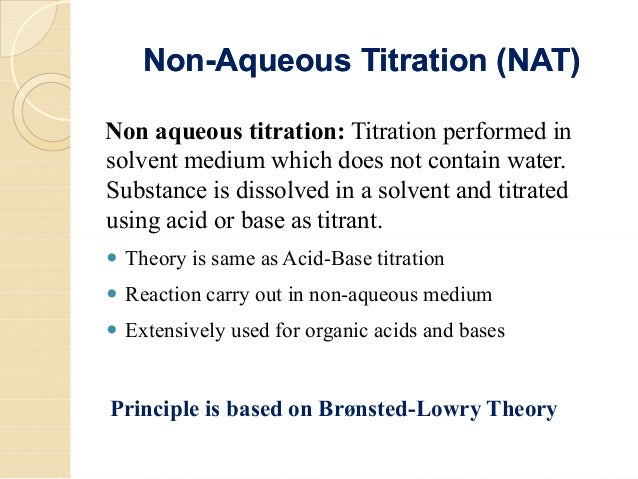
Non Aqueous Titration By Dr A Amsavel

Non Aqueous Acid Base Titrations Ppt Download
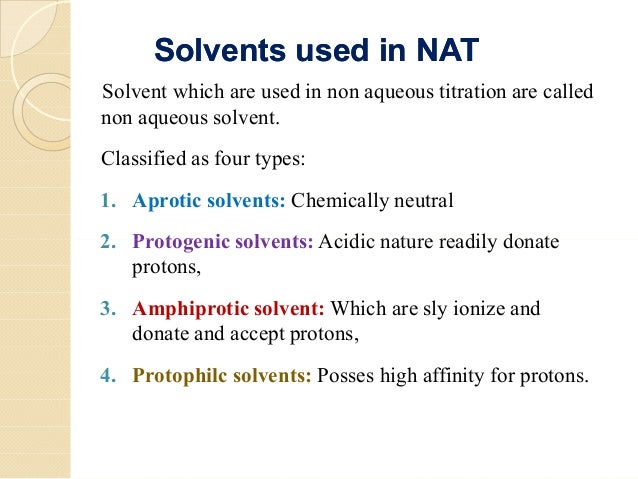
Non Aqueous Titration By Dr A Amsavel

Non Aqueous Titration Ppt Video Online Download
Non Aqueous Titration Chemical Substances Chemical Compounds

Non Aqueous Titrations By Layan H
Non Aqueous Titrations By Gunja Chtaurvedi Acid Titration
Non Aqueous Titrations By Gunja Chtaurvedi Acid Titration
Non Aqueous Titration Theory Types Advantages Disadvantages And Applications

Non Aqueous Titrations Youtube

Presentation Topic Non Aqueous Titration Ppt Video Online Download

Presentation Topic Non Aqueous Titration Ppt Video Online Download



Post a Comment for "What Is The Principle Of Non Aqueous Titration"